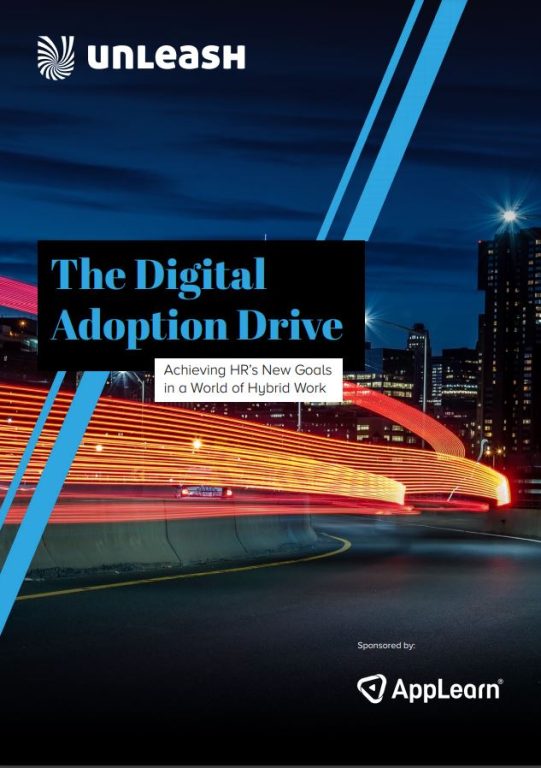Exclusive: Driving Digital HR Adoption in a Hybrid Working World
Unpacking new research into the importance of digital adoption in HR tech.
In this Report:
Learn how to keep connected with dispersed workers
Understand the optimal frequency and timing of communications
Short-term solutions vs long-term strategy
HR continues to provide the bedrock of employee safety, but the challenges surrounding this cannot be underestimated. With the best will in the world, HR was never designed for the level of chaos the COVID-19 pandemic created. And most HR tech stacks simply weren’t up to the task. So as HR leaders move to retool their organizations and look to maximize the employee experience across the full lifecycle – from hire to retire – how do we make the most of these investments?
After all, HR software can only support or reshape a business if its workforce buys into the digital transformation and uses these new systems at every turn…
Earlier this year, we published joint research in partnership with AppLearn on ‘The Digital Adoption Drive: Achieving HR’s New Goals in a World of Hybrid Work’ and some months on we all still find ourselves dealing with massive uncertainty around the reality of what hybrid work means for organizations worldwide.
This new article series explores how organizations are doing just that and harnessing their tools and technology to deliver excellent experiences and to meet business goals and priorities, even in these turbulent times.
Our HR tech research highlighted six key areas of focus in terms of HR leaders’ goals:
- Connecting the workforce with leaders
- Providing first-class employee experiences
- Improving the digital adoption of HR tech
- Driving greater value from process data
- Delivering seamless digital HR services
- Giving HR teams more autonomy
Over the past year we realized transformation is no longer just a point in time, a perfect revolution. Instead, it’s now a constant process of progress and adoption – because the HR ecosystems around us continuously changes.
Rudy Kelner, VP, Head of HR Transformation, Technology & Global Solutions, Verisk
HR departments across the globe have spent the past year transforming multiple aspects of daily working life, at pace and at scale; no mean feat. But with the ship now steadied, attention is being turned to delivering experiences that will ‘wow’ all employees, whether they are new in post, but yet to meet managers and teammates face-to-face, or established members of staff.
Our interviewees shared their thoughts about what employees now want, and the tools they need to meet these expectations. It’s neatly described by Nissan’s Vice President Global People Services, Raju Vijay, as “a consumer-grade experience”. He says: “We’re testing Robotic Process Automation, virtual assistants and chatbots for future deployment. We need the ability to provide seamless employee engagement and service that is mobile- and knowledge-enabled, on a par with modern consumer technology.”
What people demand in their personal interactions with brands and businesses, they expect from their employer – and woe betides those that don’t take note.
Better connections
Across the board, there is a renewed focus on providing superior employee experiences. This means improving the flow, frequency, and quality of communications with dispersed team members; keeping them not just informed – but also engaged.
Ben Debnath, Global Head HR Operations at Syngenta, has tasked his team with the key objective of designing and driving a better experience: “Dealing with behavioral shifts [among employees] is the big challenge, it’s not just process optimization. I use the analogy of speaking to your utility service provider, where you often get a bureaucratic rather than an emotional response. We need to stop inflicting that on employees.”
Dragging behemoth businesses into the new working world isn’t going to be easy, but some HR leaders are already making headway. Imperial Brands is devising a new approach to employee experience it dubs ‘Modern Workplace’.
This is being delivered by a cross-functional working group from HR, technology, and procurement. Cat Lightfoot, Global HR Operations & Technology Director, explains: “Employees receive a huge amount of information, from accessing Teams to using learning apps. We’re putting it all under one umbrella for a more joined-up experience, particularly as more change will come in the future due to hybrid working.”
How much is too much?
Despite the clamor for more interaction, a balance must be struck between informing and bombarding employees lest they drown in a tide of notifications about all the aspects of their job; from team collaboration to performance updates, and more administrative tasks like annual leave management. While some of our observers believed their employees desire even more communication from their organization, others worry their business overdoes it.
According to research by Constellation, more than a quarter (27%) of workers feel they waste an entire day each week on irrelevant emails and messages. This is affecting productivity. While many assumed less time spent commuting would mean more efficient output, in reality, productivity levels have only increased slightly, according to the study.
27% – more than a quarter of workers feel they waste an entire day each week on irrelevant emails and messages
Employee Experience: Moving to a Decisive New Model for the Future of Work’, Constellation Research, 2021
Meanwhile, organizations are seeking ways to ensure even vital communication doesn’t impinge on employees’ personal time, as more people mix use of work and personal devices outside normal working hours. One expert described his company’s current strategy as “clunky” and claimed it risked leaking into people’s private lives.
The same strategic issue applies to the number of different applications an organization uses; disparate platforms that HR is required to oversee, and that employees must access to do their job. Just this week, one HR leader told UNLEASH they are using an average of 11-13 platforms just for recruiting across their business.
Rationalizing is one part of this puzzle. But better integration and connectivity between systems is also key.
Many organizations have good reasons for creating an ecosystem of different HR solutions that specialize in certain areas. But understanding how these connect and work together is often lacking.
Without this though, the future of remote and hybrid working remains too manual – often leading to a poor employee experience – and doesn’t encourage enough buy-in, or foster enough trust to drive adoption and support a new vision for the world of work in 2021 and beyond.
Join us for the second article in this series that will unpack more research insights from HR leaders into their changing HR tech stack and what’s working for them (and what’s not!).

Sign up to the UNLEASH Newsletter
Get the Editor’s picks of the week delivered straight to your inbox!

Director, Competitive Intelligence
Former Director of Content Labs and Insights at UNLEASH.
